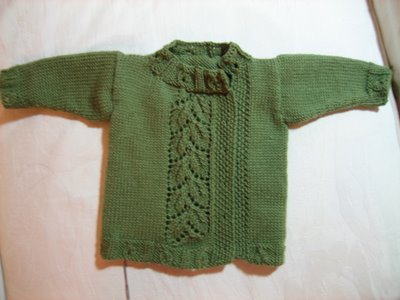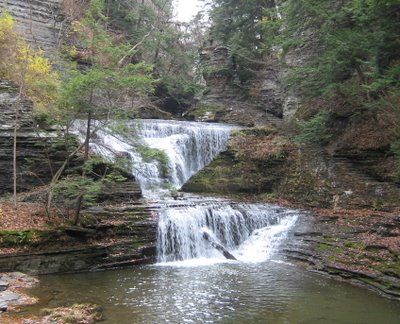
Today I have a guest blogger - Donna Druchunas, author of the just released
Arctic Lace - who has graciously agreed to write a guest post on this leg of her blog book tour. Her new book is available online at
Amazon. More information can be found on her
website.
Donna is an experienced knitwear designer whose designs have appeared in Family Circle Easy Knitting, Knitters, Piecework, Interweave Knits, Fibre Focus, and INKnitters magazines as well as pattern booklets for various yarn companies. In addition, she's a great resource for those of us who love to knit, generous with her advice and her encouragement.
Arctic Lace is emblematic of her passion for design and teaching; it is easily one of the most unique knitting books I have seen -- incorporating patterns, history, sociology, and tools for the reader to come up with their own designs. So, without further ado, her guest post:
Inspiration and Designby Donna Druchunas
One of the questions I'm asked most often is, "Where do your ideas come from?" My subconscious mind is the only answer I can come up with. I am constantly flooded with ideas for books, lace patterns, and projects. I think it's because I am open to new ideas, so I get ideas wherever I am. I'm not afraid that I won't have enough ideas. I think fear stops you from recognizing good ideas when they come to you. My guess is that everybody has good ideas all the time, but most people are not paying attention.
A few weeks ago, for example, I was looking at a pile of dyed qiviut yarn sitting on a table at a booth and I saw a modular lace scarf. The image just popped into my head as I was staring at the pile of yarn. I haven't made this yet, because of the cost of the yarn, but whenever I'm ready the idea is just sitting there in my mind. I also keep files on my computer to make lists of ideas. And sometimes I'll make a little pencil sketch, scan it, and place it into the idea file with the text.
While I was doing the research for Arctic Lace, I made photocopies of arts and crafts pieces from several books about Yup'ik and Inupiat art in my public library. I also visited the ethnology collection at the Museum of the North at the University of Alaska, Fairbanks. My husband was the photographer for Arctic Lace and he took pictures of dozens of woven baskets, ivory carvings, painted wooden utensils, and sewn bags in the collection. I also had photos from museum collections showing the daily life of Yup'ik and Inupiat people in the 19th and early 20th centuries. When I got home, I looked at these photos over and over again until a design just popped out at me.
I'm not very good at forcing designs. I just have to look at things and wait for a design to show itself to me. I'm sure that my subconscious mind is working on these ideas while I'm sleeping, showering, and driving. And then when I'm ready, the idea just comes up into consciousness.
With that said, here are a few interesting questions Connie asked me about my inspiration for Arctic Lace and for the projects in the book:
What inspired you to write a book combining history, sociology, and knitting patterns? Were you inspired by efforts by Nancy Bush and her Ethnic knit series?Yes, definitely. Nancy's book
Folk Knitting in Estonia is one of my favorite books and I kept it on my desk while I was writing
Arctic Lace. My favorite part of the book was the short chapter on Estonian folk customs and holidays. I haven't actually made any of the projects from
Folk Knitting in Estonia, but I have read the book over and over again and I am still inspired by it every time I crack the cover open.
Another of my favorite books is
Gossamer Webs by Galina Khmeleva and Carol Rasmussen Noble. I loved that the authors interviewed the Russian knitters and included their photos and quoted from their interviews in
the book. I enjoyed hearing the stories of the knitters in their own voices. This book was very much a montage, including pieces written by both authors, the quotes from the interviews, and a story about knitters that was translated from Russian.
Both of these books left me wanting to know more. Not about the knitting, that was covered in depth. But about the history and culture of the knitters. I wanted to know more of their stories, and about the yarn they use, and the animals that provide the fiber, and, and, and... So in
Arctic Lace I tried to write the kind of book that I wanted to read, even though I had never seen a book just like that before.
What is your process in designing when the jumping off point is historical in nature? Do you start with sketches and come up with a general game plan or do you start swatching with yarns immediately?I actually chart first. When an idea comes to me, I go right to the computer and chart it. When I was writing
Arctic Lace, I used Stitch and Motif Maker. I've recently switched to Knit Visualizer for charting. Both programs allow me to cut and paste and move symbols around, so I don't have to wear a hole in your graph paper with an eraser.
Because the first chart I make is never correct. I usually get the general outline of the lace pattern the way I want it, but as I start swatching, I may change my mind about what types of decreases work best in a certain spot. Sometimes I don't even like the basic outline when I'm done, so I go back to the charting program. Some designs just look much better when you add a double outline, so a boring pattern suddenly becomes interesting. Other patterns look better as individual motifs, and still others work better as all-over repeats. I experiment with all of this on the computer, and when I think I have something that I like, I swatch it in worsted or sport weight wool.
I find wool to be the easiest inexpensive yarn to swatch with. I usually use Brown Seep or Plymouth yarns because the cost is so reasonable. I like to swatch with heavier yarn and thicker needles first because then I can really see how the stitches look and I can work out the problems with the stitch before trying to knit it on tiny needles and thread-like yarn. I highly recommend this to all lace knitters: Always swatch a new lace pattern on worsted or sport weight yarn and size 7 or 5 needles. That way you can learn the pattern and make your mistakes on your swatch instead of in your real project. This is especially important when knitting with qiviut, which usually costs for about $70 US per ounce.
What is the first thing you knitted and what is the first thing you designed? What kinds of garments/objects do you gravitate towards?Let's see, the first thing I remember knitting is a yellow honey comb swatch after my grandmother taught me how to use a cable needle. The first piece of lace I ever knitted in my entire life is the swatch on page 112 of Arctic Lace. This is the swatch I use to teach new lacer knitters as well. It includes yarn overs, and three types of decreases (left slanting, right slanting, and a double decrease). I knitted this in cheap worsted weight acrylic yarn because I was sure I would mess up. I had never been able to knit lace successfully before I used the techniques I included in Arctic Lace. But once I learned the secret (or not so secret, as it turns out) techniques that I explain in
Arctic Lace, I was able to go right into designing my own lace.If I could learn to knit lace, I know that every knitter can learn, too!
I don't really like designing sweaters. I much prefer to make items that don't have to come out a specific size! Sweater patterns usually have to be written for at least 3 sizes, and I just don't enjoy figuring all of that out. It's not hard. It's just tedious. I'd rather just be knitting. So while I do design sweaters to knit for myself, I usually design accessories and other small projects for publication. Lately I find that I'm designing and knitting a lot of shawls.
Who's your favorite designer?
There are so many great designers out there today that it really is not fair to pick just one or two favorites. But....
Debbie New came to mind immediately when you asked that question. She is just so creative, that it's hard to fathom! I think I read that Debbie is a retired biologist and a mother of eight, so I can't even imagine how she found time for creativity. Everything she does it outside of the box. Her techniques are outrageous, but she uses them to create designs that regular people can wear. Of course, she makes strange things, too, like a sea-worthy lace boat that was shown in Meg Swansen’s book,
A Gathering of Lace.
I am also a big fan of Dorothy Reade. She worked with the Oomingmak co-op at the beginning to develop the knitting techniques and yarn that they use for their lace scarves, stoles, and hats. She also wrote and self published one book and several other booklets. Her book,
25 Original Knitting Designs, is out of print and very hard to find, but it is full of wonderful charted lace designs that she created from scratch. There are no projects in the book, but she gives several ideas on how the knitter can incorporate the lace patterns into existing projects.

























